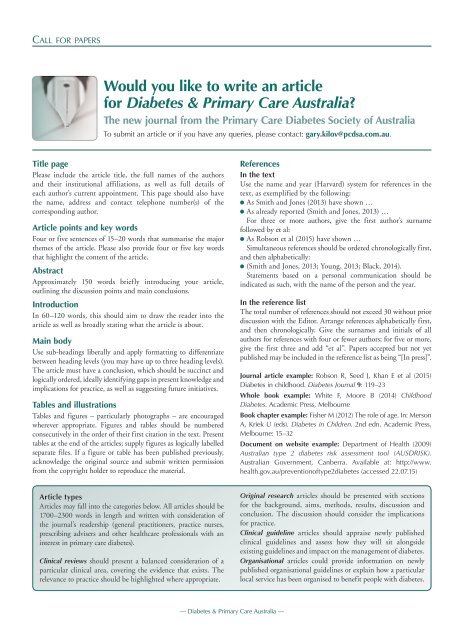DPCA2-1
You also want an ePaper? Increase the reach of your titles
YUMPU automatically turns print PDFs into web optimized ePapers that Google loves.
Call for papers<br />
Would you like to write an article<br />
for Diabetes & Primary Care Australia?<br />
The new journal from the Primary Care Diabetes Society of Australia<br />
To submit an article or if you have any queries, please contact: gary.kilov@pcdsa.com.au.<br />
Title page<br />
Please include the article title, the full names of the authors<br />
and their institutional affiliations, as well as full details of<br />
each author’s current appointment. This page should also have<br />
the name, address and contact telephone number(s) of the<br />
corresponding author.<br />
Article points and key words<br />
Four or five sentences of 15–20 words that summarise the major<br />
themes of the article. Please also provide four or five key words<br />
that highlight the content of the article.<br />
Abstract<br />
Approximately 150 words briefly introducing your article,<br />
outlining the discussion points and main conclusions.<br />
Introduction<br />
In 60–120 words, this should aim to draw the reader into the<br />
article as well as broadly stating what the article is about.<br />
Main body<br />
Use sub-headings liberally and apply formatting to differentiate<br />
between heading levels (you may have up to three heading levels).<br />
The article must have a conclusion, which should be succinct and<br />
logically ordered, ideally identifying gaps in present knowledge and<br />
implications for practice, as well as suggesting future initiatives.<br />
Tables and illustrations<br />
Tables and figures – particularly photographs – are encouraged<br />
wherever appropriate. Figures and tables should be numbered<br />
consecutively in the order of their first citation in the text. Present<br />
tables at the end of the articles; supply figures as logically labelled<br />
separate files. If a figure or table has been published previously,<br />
acknowledge the original source and submit written permission<br />
from the copyright holder to reproduce the material.<br />
References<br />
In the text<br />
Use the name and year (Harvard) system for references in the<br />
text, as exemplified by the following:<br />
● As Smith and Jones (2013) have shown …<br />
● As already reported (Smith and Jones, 2013) …<br />
For three or more authors, give the first author’s surname<br />
followed by et al:<br />
● As Robson et al (2015) have shown …<br />
Simultaneous references should be ordered chronologically first,<br />
and then alphabetically:<br />
● (Smith and Jones, 2013; Young, 2013; Black, 2014).<br />
Statements based on a personal communication should be<br />
indicated as such, with the name of the person and the year.<br />
In the reference list<br />
The total number of references should not exceed 30 without prior<br />
discussion with the Editor. Arrange references alphabetically first,<br />
and then chronologically. Give the surnames and initials of all<br />
authors for references with four or fewer authors; for five or more,<br />
give the first three and add “et al”. Papers accepted but not yet<br />
published may be included in the reference list as being “[In press]”.<br />
Journal article example: Robson R, Seed J, Khan E et al (2015)<br />
Diabetes in childhood. Diabetes Journal 9: 119–23<br />
Whole book example: White F, Moore B (2014) Childhood<br />
Diabetes. Academic Press, Melbourne<br />
Book chapter example: Fisher M (2012) The role of age. In: Merson<br />
A, Kriek U (eds). Diabetes in Children. 2nd edn. Academic Press,<br />
Melbourne: 15–32<br />
Document on website example: Department of Health (2009)<br />
Australian type 2 diabetes risk assessment tool (AUSDRISK).<br />
Australian Government, Canberra. Available at: http://www.<br />
health.gov.au/preventionoftype2diabetes (accessed 22.07.15)<br />
Article types<br />
Articles may fall into the categories below. All articles should be<br />
1700–2300 words in length and written with consideration of<br />
the journal’s readership (general practitioners, practice nurses,<br />
prescribing advisers and other healthcare professionals with an<br />
interest in primary care diabetes).<br />
Clinical reviews should present a balanced consideration of a<br />
particular clinical area, covering the evidence that exists. The<br />
relevance to practice should be highlighted where appropriate.<br />
Original research articles should be presented with sections<br />
for the background, aims, methods, results, discussion and<br />
conclusion. The discussion should consider the implications<br />
for practice.<br />
Clinical guideline articles should appraise newly published<br />
clinical guidelines and assess how they will sit alongside<br />
existing guidelines and impact on the management of diabetes.<br />
Organisational articles could provide information on newly<br />
published organisational guidelines or explain how a particular<br />
local service has been organised to benefit people with diabetes.<br />
— Diabetes & Primary Care Australia —
















